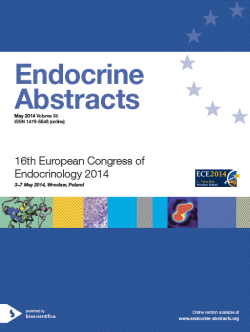Searchable abstracts of presentations at key conferences in endocrinology
Symposia
Endocrine Nurses Session 1: Craniopharyngioma
ea0035s4.1 | Endocrine Nurses Session 1: Craniopharyngioma | ECE2014
Craniopharyngioma: challenges in the management of patients with craniopharyngioma
Craniopharyngiomas are partly cystic embryogenic malformations of the sellar and parasellar region. With an overall incidence of 0.52.0 new cases/million population per year, ~3050% of all cases represent childhood craniopharyngioma. Typical manifestations at diagnosis are some combination of headache, visual impairment, polyuria/polydypsia, growth retardation, and significant weight gain. Therapy of choice in patients with favorable tumor localization is complete ...
ea0035s4.2 | Endocrine Nurses Session 1: Craniopharyngioma | ECE2014
The role of the endocrine nurse in the long term care and treatment of patients post craniopharyngioma
After the crisis of diagnosis and surgery for craniopharyngioma, patients and families are immediately faced with the lifetime challenge of pituitary replacement therapy. The endocrine nurse assists the patient in adapting to the regimen required for a return to normal hormonal balance and optimal health. Nurses teach the purpose of prescribed hormones, and reinforce the most effective method and scheduling of each medication; this must be individualized for each patient. Defi...
ea0035s4.3 | Endocrine Nurses Session 1: Craniopharyngioma | ECE2014
Psychological aspects of living with a pituitary related condition
There is estimated to be 60 000 people with pituitary disease in the UK. Reports have identified a number of concerns and unmet psychological needs in this patient population. Many patients with pituitary disorders remain isolated, alienated, and distressed. Research has suggested that patient distress may not be identified by healthcare professionals (HCPs), resulting in significant morbidity, additional use of primary and secondary care services, and patient dissatisfaction ...




